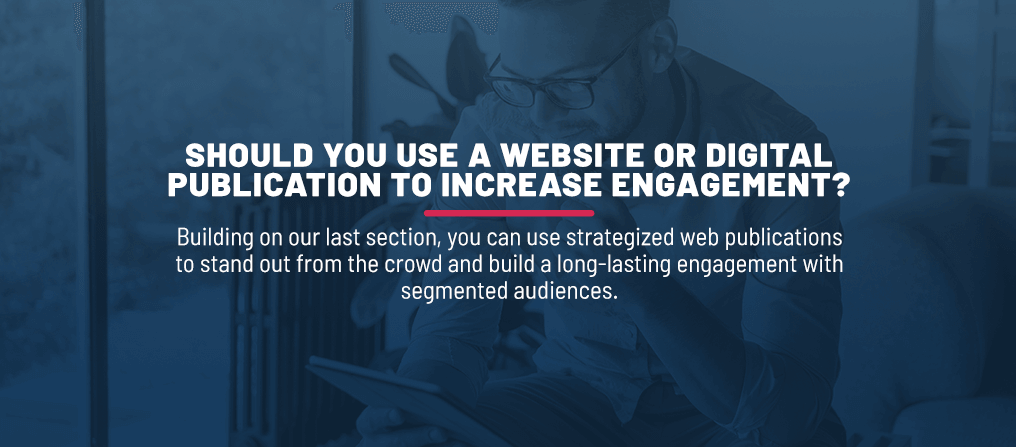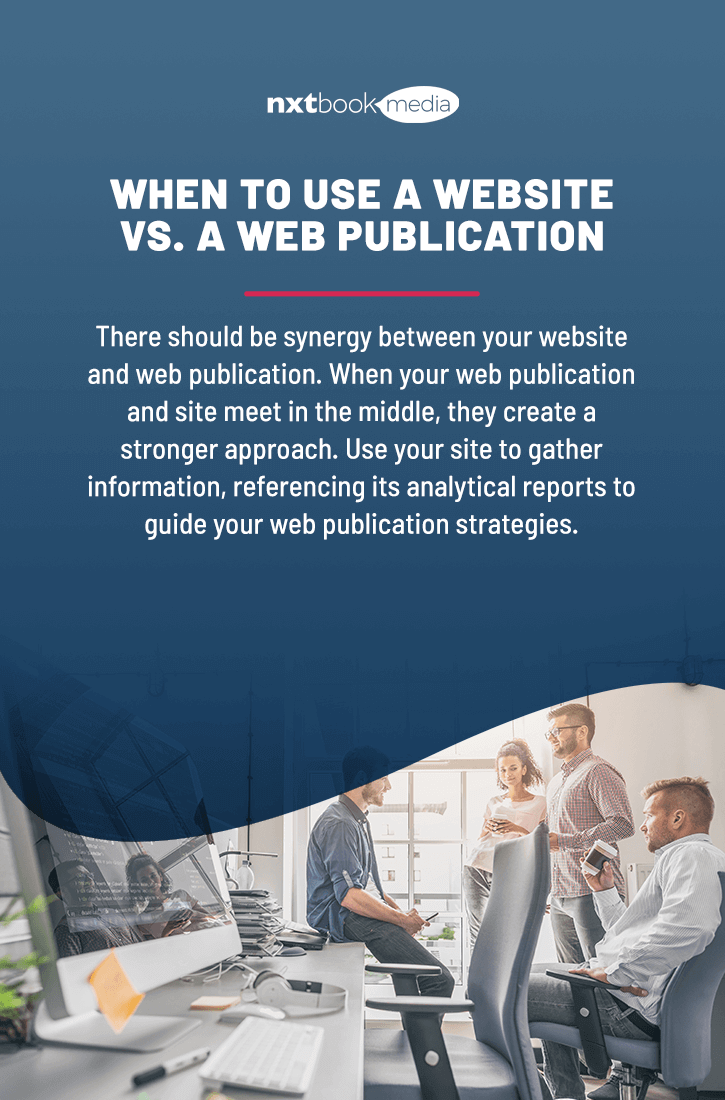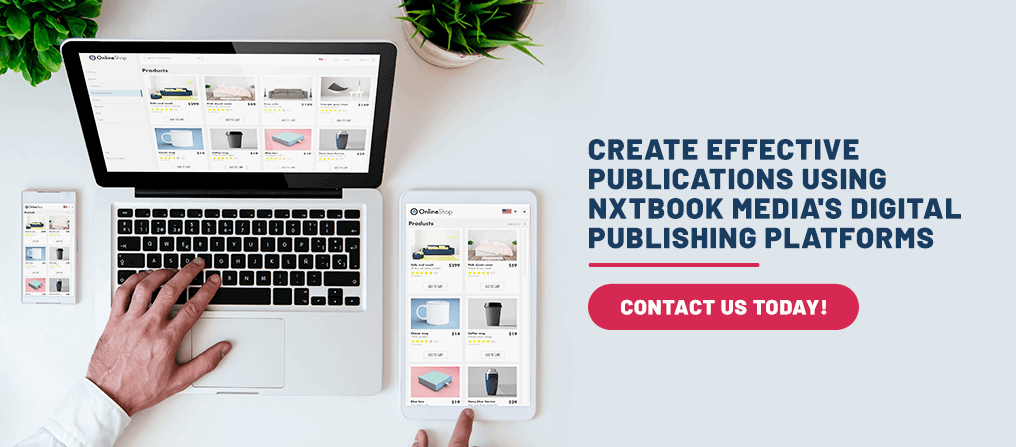Websites vs. Web Publications — When and How to Use Both

Written by Matt Berringer
October 15, 2020
In 2020, every business should have a website. Websites act as a powerhouse to share information with customers and promote products and services. You might share information through about pages, blog posts, product or service pages and contact forms — the list goes on, creating a maze of internal links, which has pros and cons.
Now, the web is experiencing a transformational shift using web publications. Web publications work hand-in-hand with websites to share even more engaging, personalized media to customers without them navigating a maze of information.
Both websites and web publications are important for building a strong brand. Here, we’ll walk you through how and when to use both platforms to grow your business.
What Is a Web Publication?
A web publication — also referred to as a digital publication — is a media-rich web-space where businesses can curate important information for their customers. Before we get too deep into why web publications are a good pairing for websites, let’s look at some examples.
Web publications transform material on your website into interactive media, like:
- Flipbooks.
- E-books.
- Product catalogs.
- User manuals.
- Brochures.
- Magazines.
- Sales pitches.
- Newsletters.
- Annual reports.
- Photo galleries.
These web publications have their own URL and web identity apart from your website. Customers find your web publications through calls-to-action (CTAs), which your team can compose via email, blog post, text message and more.
As a real-world example, you might be familiar with one of the top luxury travel brands, Norwegian Cruise Line. Passengers enjoy a relaxing getaway to a waterfront destination, where they rely on Norwegian’s content and expertise to guide their vacations and excursions. Understanding this, Norwegian created a user-friendly digital brochure with features like:
- Videos.
- Slideshow content.
- Flipbooks.
- Brand images.
- Effective CTAs and internal links.
- Mobile-friendly interfaces.
The digital brochure creates an immersive experience for vacationers during their research stage, making them feel like they’re already on a Norwegian cruise — ultimately driving the purchase of a Norwegian vacation package. Additionally, the brand intertwined internal linking and other content marketing strategies to drive traffic to their website and perform better on Google search engine results pages (SERPs), generating even more high-quality leads.
Standing Out From the Crowd
At the time of publishing this article, there are over 1.8 billion websites, and that number increases every second. Can you imagine all the mass content produced for those sites? This content is what’s referred to as “the crowd.”
You want your content to be so engaging that your target user notices your brand among others. More specifically, your goal is to attract and find customers with some sort of need or interest in your brand’s offerings, then inspire them to start a long-term relationship.
You can help your brand stand out from the crowd with the tips below.
Personalized and Relevant Content
Some people use personalization and relevance interchangeably, but there’s a slight difference when talking about marketing content strategies:
- Personalization: Personalization addresses an individual’s or defined group’s unique needs, sometimes tracked by the user’s or group’s historical web data. Have you ever opened an email advertisement and noticed they addressed you by name? Other people didn’t get the email with your name on it — it was personalized for you.
- Relevance: Relevance is on a broader spectrum and answers the question, “Does the user have a need for this information?” Content can be relevant but have little to no personal connection to your user. For example, Google will show very different results for a person in California and one in New York for “best pizza places near me.” The location is relevant, but the search results are not organized based on the person’s favorite pizza toppings — at least, not in 2020.
Personalization and relevance work hand-in-hand to attract the right customers at the right time. Suppose a user is looking into the crowd for the best pizza place. They’ll notice you if you’re jumping up and down and speaking directly to them, rather than your competitors who are trying to target a less-personalized group of people.
Transactional vs. Inspirational Content
Transactional and inspirational content also work simultaneously, acting as a harmonious duo that paves the user’s path to a profitable, long-term relationship with your brand. You want both kinds of content for these reasons:
- Transactional: This term refers to content that drives sales. Transactional content can be product claims, pricing pages, client testimonials or anything else that conveys your brand’s superiority and creates a sense of urgency.
- Inspirational: This type of content takes a different approach. Inspirational content is user-focused, sparking emotion by communicating how your brand will make the consumer feel better about themselves.
Business strategies have changed dramatically from using aggressive sales techniques to understanding the importance and profitability of relationship-building.
Think of these content types like a sales pitch. You likely wouldn’t start by asking for people’s credit card information. Instead, you’d introduce yourself and alter your sales pitch to your audience’s unique needs, showing them how your product and service benefit them directly.
Should You Use a Website or Digital Publication to Stand Out Against the Crowd?
Use digital publications to stand out from the crowd and personalize your offerings. Digital publications are highly inspirational, and certain publication types — such as catalogs — effectively generate transactions. Don’t turn a cold shoulder to your website, though, because it can stand out in many other ways, too.
Digital publications are personalized content and experiences, detailed in the next section, which paint a complete picture of how the user can benefit from your product or service. Simply put, digital publications speak to a segmented audience, while websites speak to the entirety of an audience. Both are important and have their respective time and place.
Guiding Readers and Increasing Engagement
Your next step is crucial. It would be a waste of time and resources if you successfully captured a user’s attention, then lost them only a few seconds after your relationship started. Keep the ball rolling by creating a personalized experience that impresses your user and entices them to view you as an industry leader.
Guide your readers to this perception and increase user engagement with the following advice.
Creating Custom Experiences
Your brand is three-dimensional, and your content should be, too. Users want to do more than scroll mindlessly through text with no clickable content, like in PDFs. Instead, users crave an experience that allows them to open doors and learn about your brand’s different layers.
Examples of content that creates custom experiences include:
- Easy navigational tools.
- Search features.
- Embedded videos.
- Sliders.
- Interactive visuals.
- Quizzes.
- Surveys and polls.
These interactive publication examples keep users engaged, allowing them to guide their own exploration. You provide strategized tools and information, which encourages people to interact with the most meaningful information to them.
Curating Content for Readers
Intertwined with a custom experience, curated content entails picking and choosing the right subject matter and presenting it at the right time. This comes with the overall goal of showcasing yourself as a thought leader within your industry.
Your content should be organized and share a common denominator — in most cases, your business’s morals, value statement or mission statement. Curated content should also be innovative, expressing unique ideas and solutions that are powerful enough that users believe you’re the superior choice in the crowd.
Curated digital content leaves a lasting, favorable impression of your brand in users’ heads, making them more likely to trust and revisit your company in the future.

Should You Use a Website or Digital Publication to Increase Engagement?
You can integrate custom experiences and curated content on your website, but web publications are far more effective platforms to use. Ideally, you should use both, with a concentration on your digital publication.
On your website, users can take a bunch of different lefts and rights to navigate through information. Sure, there’s a lot of useful knowledge on your site, but you want an effective sidekick to help categorize that information to increase engagement in the right audience segments.
Web publications allow you to curate content following a single path. Building on our last section, you can use strategized web publications to stand out from the crowd and build a long-lasting engagement with segmented audiences.
Understanding How Digital Platforms Drive ROI
Return on investment (ROI) allows you to determine your platforms’ health and overall effectiveness. A healthy ROI relies on the following factors:
- Understanding your customers’ needs.
- Enhancing user engagement by employing innovative customer experiences.
- Tracking user engagement and overall performance.
- Altering content using data-informed decisions.
You can determine how healthy your ROI is by tracking different key performance indicators (KPIs) established by your team. Your KPIs will look different depending on your platform and goals, but some common examples include:
- Clicks.
- Downloads.
- Bounce rates.
- Shares.
- Views.
- Conversions.
Embedding AT Internet, Google Analytics or other third-party tools allows you to track these KPIs. Tracking and analyzing KPIs highlights critical information — like your audience’s likes and dislikes — that you can use to shape your future marketing strategies.
Driving ROI Through Digital Experiences
At this point, you’ve successfully stood out from the crowd and established a solid foundation for a long-term relationship with your customers. Now, you want to strategize ways to keep that profitable connection alive.
Think of your personal relationships. When you meet someone, you share surface-level interests that spark a connection. As you get to know the person, your kinship branches in different directions, and your shared experiences change. Additionally, the interests you share with one friend may not be the same as the interests you share with another.
Transitioning this concept into a marketing strategy, you can use digital publications to drive ROI in ways like:
- Higher-quality leads: Digital experiences are personalized to specific segments of your overall audience. These personalized messages are the “spark” that makes you stand out from the crowd and attract higher-quality leads.
- Rich content: With higher-quality leads, you can take their personalized interests and transform them into rich, responsive content — like forms, surveys, polls and more — that branches out from the initial spark.
- Longer engagement: Because you have the advantage of knowing their interests and engagement rates, you can strategize responsive content to keep your segmented audience engaged for longer periods.
Additionally, from an internal management perspective, tracking KPIs allows you to:
- Increase productivity: You’ll see which digital experiences work well and which don’t. Using this information, you can restructure strategies to reach your KPI goals productively.
- Lower costs: As you track KPIs, your management team can eliminate strategies that aren’t stimulating your audience segment. This allows you to allocate more finances to other techniques or reduce overhead costs altogether.
By combining this internal management perspective and digital experience methods, you can change each audience segments’ view of your brand. Doing this keeps your brand relevant and maintains a positive ROI.
Should You Use a Website or Digital Publication to Drive ROI?
Digital publications are powerful ROI-driving tools you should use in partnership with your website. Compared to sites, web publications are more effective at:
- Targeting the right audiences.
- Capturing high-quality leads.
- Sharing the right information.
- Keeping users engaged.
You shouldn’t ignore your website-specific KPIs and performance, but you should expect to earn more revenue from web publications than websites if investing the same amount of money.
Both are important, but sites limit the customer journey and draw generalized attention. Take the information you learn from your website and use it to segment your audience and generate stronger digital experiences through web publications.
Understanding How to Build Digital Assets and Resources
Knowing the benefits of websites and web publications is great, but how exactly do you create each digital asset, and how will that affect your costs? The answer depends on two things:
- The technical knowledge you need to design and build each asset.
- The time it takes to conceptualize and launch each asset.
Usually, the more technical knowledge and time required, the more money you’ll need to invest. Consider the following comparisons between websites and web publications when choosing which asset to use in your marketing strategy.
Required Technical Knowledge
Creating a website is no simple task. It requires an extensive amount of technical knowledge, both in web design, which makes the website pretty, and web development, which makes it functional.
Website developers and designers require a deep understanding of:
- HTML.
- CSS.
- JQuery.
- Website scripting.
- Domain and hosting.
- Open-source technology, like WordPress.
- Art philosophy.
- Design applications, like Adobe Photoshop and Illustrator.
Comparatively, web publications don’t require nearly as much technical knowledge.
You can easily find web publication software that will do all the coding and hosting for you. A quality web publication software solution will provide you a blank canvas, where you get to do the fun part of designing digital experiences suited to your audience with easy-to-use tools.
Estimated Time Frame to Launch
Because websites are so complex, they take a decent amount of time to launch. In a typical 12-week process, sites go through three stages of development:
- Creating a detailed outline, or a rough sketch, of the website.
- Building the conceptualized design.
- Making modifications and fixing any bugs before launch.
Web publications follow a similar design process but take a fraction of the time to launch. The estimated time frame to launch depends on your web publication, but it can take as little as a few hours for simple publications.
Plus, you don’t need a programmer to build and update your digital publication, unlike a website. The web publication software makes it easy to create, fix, and update your publication during every step of development and post-launch. Some web publication companies (like Nxtbook Media) even provide production assistance to help you design, develop, and publish your content quickly and easily.
Should You Use a Website or Digital Publication to Build Assets and Resources?
Websites are a must. But, when creating content and expanding your brand, digital publications require less time, technical knowledge and money.
Because digital publications are proven to generate higher ROI than websites, allocate a portion of your budget to website maintenance, and invest the remainder into regularly creating and publishing digital publications.
When to Use a Website vs. a Web Publication
You shouldn’t choose one option over the other. Both websites and web publications are important. Instead, learn how you can use both harmoniously within your marketing strategy.
Websites are the powerhouse of your digital brand. Everyone in your audience can benefit from visiting your site. It can:
- Communicate your products and services.
- Share stories about your brand.
- Provide information about your brand, such as how and where to contact sales associates.
- Finalize transactions.
These are extremely important elements of your content. However, there’s so much information on your website that your audience has to fish through extra information to find what they’re really interested in. That’s where web publications come into play.
Web publications are snack-sized digital experiences that target segmented groups of your audience. Each audience segment has different interests. Use these interests to deliver a focused and engaging customer journey, resulting in higher-quality leads and increased revenue.
There should be synergy between your website and web publication. When your web publication and site meet in the middle, they create a stronger approach. Use your site to gather information, referencing its analytical reports to guide your web publication strategies. Share your web publications on your website or through other marketing channels, such as email marketing.
Case Study — Marriott Creates Synergy Using Website and Web Publications
Marriott is a powerful business in the hospitality industry, offering over 1.1 million hotel rooms across 5,700 properties in 110 countries. Marriott’s site shares a range of information, like:
- Career opportunities.
- Their mission and value statements.
- The different brands they operate under.
- Investment opportunities.
- Top travel destinations.
All of this information is crucial to developing their brand, but it’s not necessarily useful for an audience member looking to travel to a specific destination — which, in this case study, is Mt. Laurel, New Jersey.
Marriott understands that to generate sales, they need to segment their audience and tailor their offerings to their unique needs. Consequently, Marriott created a digital brochure to speak directly to that market. The digital brochure includes:
- The brand — Springhill Suites — that represents Marriott in Mt. Laurel.
- The different amenities of the Mt. Laurel location.
- Engaging images of the Springhill Suites hotel.
- Contact information of the Mt. Laurel Corporate Center.
If an audience member visited the website, they would have to navigate through a maze of different webpages to find the user-specific information. Comparatively, the digital brochure outlines personalized and relevant digital content the audience member needs, which secures a higher probability that they will book a hotel room at the Mt. Laurel location. This digital publication example shows how effective and creative this mode of customer communication can be.
Create Effective Publications Using Nxtbook Media’s Digital Publishing Platforms
At Nxtbook Media, we hope to inspire businesses large and small to push digital boundaries. You work hard to build your brand, and it deserves recognition and quality support. That’s why we created interactive digital content solutions to increase your brand visibility and capture the right audience’s attention.
Using decades of experience, we’ve created two digital content platforms:
- PageRaft: Your users can scroll vertically and horizontally through customizable and engaging content designed to keep your visitor engaged for an average of seven minutes per visit. PageRaft is suited for content types like magazines, brochures, guides, e-books, white papers and booklets.
- nxtbook4: Designed to transform your print or PDF document, our nxtbook4 platform integrates customizable elements like animations, podcast embedding, slideshows, web windows and more.
Contact Nxtbook Media today, and we’ll help you determine the best platform that complements your brand’s current situation, challenges and goals. We’ll get to know you, and together we’ll create a detailed plan to maximize your content’s potential.
If you’re ready to strengthen your digital content, fill out our contact form. Or, call our Partnership Development Team at 866-268-1219 and select option 6. We look forward to learning about your digital brand!







